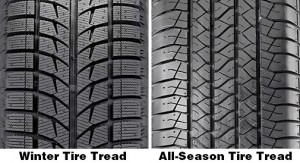There are several factors to consider when deciding on all season tires or snow tires. When it comes down to it though, it really depends on where you live and what conditions you typically drive in year in and year out. For those of us who live in the Northeast and experience all four seasons, snow tires will most likely be your best bet.
All Season
All season tires get better fuel economy and are designed to perform in a variety of conditions like wet roads and light winter driving but will not handle as well in more extreme weather. They will not provide as much gripping and handling as you would receive with winter and summer tires but if the conditions don’t require it then all season tires will be fine.
Winter and Snow Tires
Winter and snow tires are designed to perform on all conditions that range from heavy snow fall to black ice. This is accomplished through tread rubber, tread depth, tires patterns and biting edges.
- Anyone who experiences cold enough temperatures is going to experience a stiffening of tread rubber in their all season tires as well as a decrease in tire pressure which decreases the amount of traction they will produce. Winter tires are build with a flexible tread rubber that will adjust itself to provide the best grip.
- Snow tires also have a deeper tread depth so it can allow for more snow build up without causing a decrease in performance. The different tread patterns on snow tires will channel snow and slush and will have the ability to expel water.
- Finally snow tires have more biting edges and high sipe densities which is essentially more slits along the tire treads to provide for more traction on ice.
Anyone who lives in the Northeast should seriously consider buying snow tires. Here they are more of a need than a want. It is also important not to keep snow tires on all year long or they will wear very quickly. Their material is not meant for dry conditions. It’s usually a good rule of thumb to put your snow tires on around Thanksgiving considering you never know how early the first snow fall will be. Snow tires tend to be switched out around Easter time or the end of March depending on how late Easter falls.







